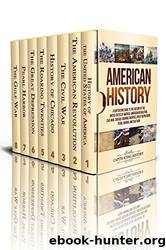American History_ A Captivating Guide to the History of the United States of America, American Revolution, Civil War, Chicago, Roaring Twenties, Great Depression, Pearl Harbor, and Gulf War by Captivating History

Author:Captivating History
Language: eng
Format: mobi
Published: 0101-01-01T00:00:00+00:00
Chapter 4 â The Cost of Prohibition
The passage of two constitutional amendments in one year was practically unheard of in US history. Other than the Bill of Rights and the Reconstruction amendments, changes to the Constitution came slowly, if at all. Two of the great social causes of the latter half of the nineteenth and early twentieth century had reached fruition. The cause of womenâs suffrage would not be retracted in the ensuing years. The idea of repealing the Nineteenth Amendment seems ludicrous to modern sensibilities. Though the fight for total equality for women continues, taking away the right to vote is preposterous.
Amazingly, it is equally preposterous to modern thinking that there was ever a time where there was a complete ban on alcohol in the United States. People wonder how did lawmakers ever think that prohibition was a good idea? What were they thinking?
That has been the question historians have been trying to answer almost since the Eighteenth Amendment was repealed in 1933. One of the first answers to these questions revolves around the perceived popularity of prohibition. Lawmakers from the federal to the most local level were overwhelmingly in favor of prohibition. Many took this stance out of fear of reprisal from the ASL and their very effective pressure techniques to ensure compliance with their agenda. So as the amendment made its way through Congress then the statehouses across the nation, many policymakers were sure that the enforcement of the amendment wouldnât be a great challenge since, at least according to the number the ASL provided, the people wanted this amendment.
Along these same lines, many people saw prohibition as something for other people to worry about. The strongest support for the amendment came from rural areas of the nation and the amendment was seen as a means to clean up the vices of the city, especially the immigrant and working-class areas of the cities, since these were seen as the worst parts of any given urban area. Similarly, the middle and upper-class people of the cities saw prohibition as a way to clean up the worst part of their cities. Prior to when the law went into effect, many upper-class citizens bought a great deal of alcohol to stock in their cellars. It may be good for the nation as a whole to go dry, but that shouldnât preclude having wine at dinner. Interestingly, when it came to enforcing prohibition, the federal government had much more success in rural areas than it ever did in urban ones.
It was this hubris that contributed to the lack of funding given to the enforcement of prohibition. Up until the Nineteenth Amendment, federal oversight over any single program was more the exception than the rule. To that end, only about $500,000 was spent on prohibition enforcement in 1923. Only 1,500 agents were created within the new Prohibition Bureau (at first housed in the IRS) to enforce the law for the entire nation.
Whatâs more, the Volstead Act, the congressional act that actually created the laws to govern prohibition, was confusing and seemed contradictory at times.
Download
This site does not store any files on its server. We only index and link to content provided by other sites. Please contact the content providers to delete copyright contents if any and email us, we'll remove relevant links or contents immediately.
Navigation and Map Reading by K Andrew(4893)
Spare by Prince Harry The Duke of Sussex(4804)
Tuesdays with Morrie by Mitch Albom(4411)
Cracking the GRE Premium Edition with 6 Practice Tests, 2015 (Graduate School Test Preparation) by Princeton Review(4053)
Machine Learning at Scale with H2O by Gregory Keys | David Whiting(3660)
What It Really Takes to Get Into Ivy League and Other Highly Selective Colleges by Hughes Chuck(3561)
Never by Ken Follett(3549)
Goodbye Paradise(3460)
Harry Potter and the Prisoner of Azkaban (Book 3) by J. K. Rowling(3123)
Pledged by Alexandra Robbins(3052)
Kick Ass in College: Highest Rated "How to Study in College" Book | 77 Ninja Study Skills Tips and Career Strategies | Motivational for College Students: A Guerrilla Guide to College Success by Fox Gunnar(3003)
Fairy Tale by Stephen King(2967)
A Dictionary of Sociology by Unknown(2862)
Sapiens and Homo Deus by Yuval Noah Harari(2857)
Reminders of Him: A Novel by Colleen Hoover(2780)
The Social Psychology of Inequality by Unknown(2774)
Graduate Admissions Essays, Fourth Edition: Write Your Way into the Graduate School of Your Choice (Graduate Admissions Essays: Write Your Way Into the) by Asher Donald(2743)
Get into Any College by Tanabe Gen Tanabe Kelly(2634)
Zero to Make by David Lang(2634)
